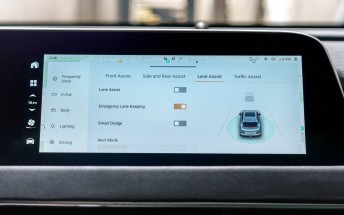Flashback: the time when SIM cards and microSD cards merged into one

In a past installment we looked at the history of the memory card. The microSD emerged as the clear victor, but it might soon follow MMC and Memory Stick into the great beyond, at least as far as smartphones are concerned.
These days a microSD slot is a rare sight. Even SIM cards are starting to sweat as Apple is sticking with its eSIM-only approach that started last year. Yes, it’s only in the US for now, but that seems more because of limited eSIM support by carriers globally than anything else, Apple’s preference seems clear – no card slots! And yes, we know that Apple wasn’t the first to go eSIM-only, but it’s certainly the most influential company to do so.
The future now looks scary for those who love the utility of cards – changing phones is as simple as popping out the SIM (no carrier approval needed like with eSIM) and moving a huge MP3 or FLAC collection is as easy as getting the microSD out of a card reader and into the phone.
But once the future looked bright – SIM and microSD were going to join forces and be stronger together. That idea never took off, unfortunately. If you’re confused, we’re talking about the SuperSIM format.
 SuperSIMs combined SIM and microSD cards into one package
SuperSIMs combined SIM and microSD cards into one package
Those emerged in 2020 in China and combined the functionality of both. Physically, they were the same shape as a microSD, however, they had extra connectors that lined up just right with the pins of a hybrid microSD/SIM tray.
This way people with phones that had hybrid card trays didn’t have to choose between extra storage and a second phone line, they could have both. And at a low price too, a 32GB SuperSIM was CNY 100 (around $14 at the time), a 64GB card was CNY 200 (~$28), there 128GB cards too and later on 256GB models as well.
They offered sequential transfer speeds of 90MB/s reads and 60MB/s writes. Not as fast as some of the best microSD cards even in 2020, but not awful either. Of course, once the standard was established, it would have been easy to increase storage capacity and speed over the years.

Besides extending storage, these cards functioned as backups too and could help when transferring to a new phone – the carriers that supported the format released an app that would store your address book, photos, apps and other data on the card, ready to be restored on a new phone, all without touching the cloud.
As far as we can tell, there was no digital connection between the SIM portion and the microSD portion of the card, this was just a 2-in-1 package. And as it turns out, some enterprising folks made their own “SuperSIM” cards years before carriers came out with an official product.



Making a “SuperSIM” card at home
They figured out that with the right combination of cutting, sanding and gluing, you put a SIM on the back of a microSD in a way that both are accessible to the phone. It was a delicate operation, but doable with basic tools and some courage. You can read more about the homemade SuperSIM cards over on iNEWS.
The format never really took off – if you look up “Super SIM” today, you will find a lot of regular SIMs that are “super” because of their extended roaming coverage.
There is also Huawei’s NM (“nano memory”) card format, which went the other way – nanoSIM-shaped memory cards. These were introduced with the Mate 20 series after Huawei talked Toshiba into backing the format (and they tried to get the blessing of the SD Alliance to make it a global standard).
 Huawei and Toshiba’s NM card
Huawei and Toshiba’s NM card
The original NM cards topped out at 256GB capacity and that hasn’t changed 5 years later. The latest Mate 60 phones still support NM, but no other maker adopted it besides Honor (but this was before the split). Benchmarks of NM cards showed microSD-like performance.
In 2020 Lexar introduced 64GB, 128GB and 256GB NM cards costing CNY 200, CNY 300 and CNY 600, respectively, making them pricier than SuperSIMs. Searching places like AliExpress shows that more manufacturers have started producing NM cards since then, but there are none over 256GB.
 Lexar’s NM cards
Lexar’s NM cards
Note that NM is a pure memory card unlike SuperSIM. That means that dual-card trays still make you choose between more memory or a second phone line. That’s probably not why NM never caught on, though.
microSD cards are cheap and plentiful, however, a lot of makers prefer charging buyers $100 extra to go from 128GB to 256GB. You can get a 2TB NVMe SSD for that kind of cash, 128GB of flash memory really doesn’t cost that much.
What do you think – was SuperSIM a brilliant or a dumb idea? What about NM cards?
Related
Reader comments
- Snake
- 21 Jun 2024
- 3eP
This trend by OEMs of "cancelling" the uSD slots is IMHO nothing less than corporate diktat, and 1st-World Privilege at ts very best (or worst depending on your stance) !! Foregoing the ease of expanding the user's storage (and of mo...
- Coast
- 14 Oct 2023
- 0TG
"Well you don't need SD cards they are too slow and base storage is plentiful" That's gotta be first world privilege if I've ever seen it. Sure, go buy a cloud subscription so it's an utter hassle to move stuff and take ...
- Jose
- 04 Oct 2023
- 8AU
With esim, I wish micro SD cards came back, I doubt it, but one can only dream.








 Xiaomi
Xiaomi Samsung
Samsung Samsung
Samsung Nothing
Nothing OnePlus
OnePlus


